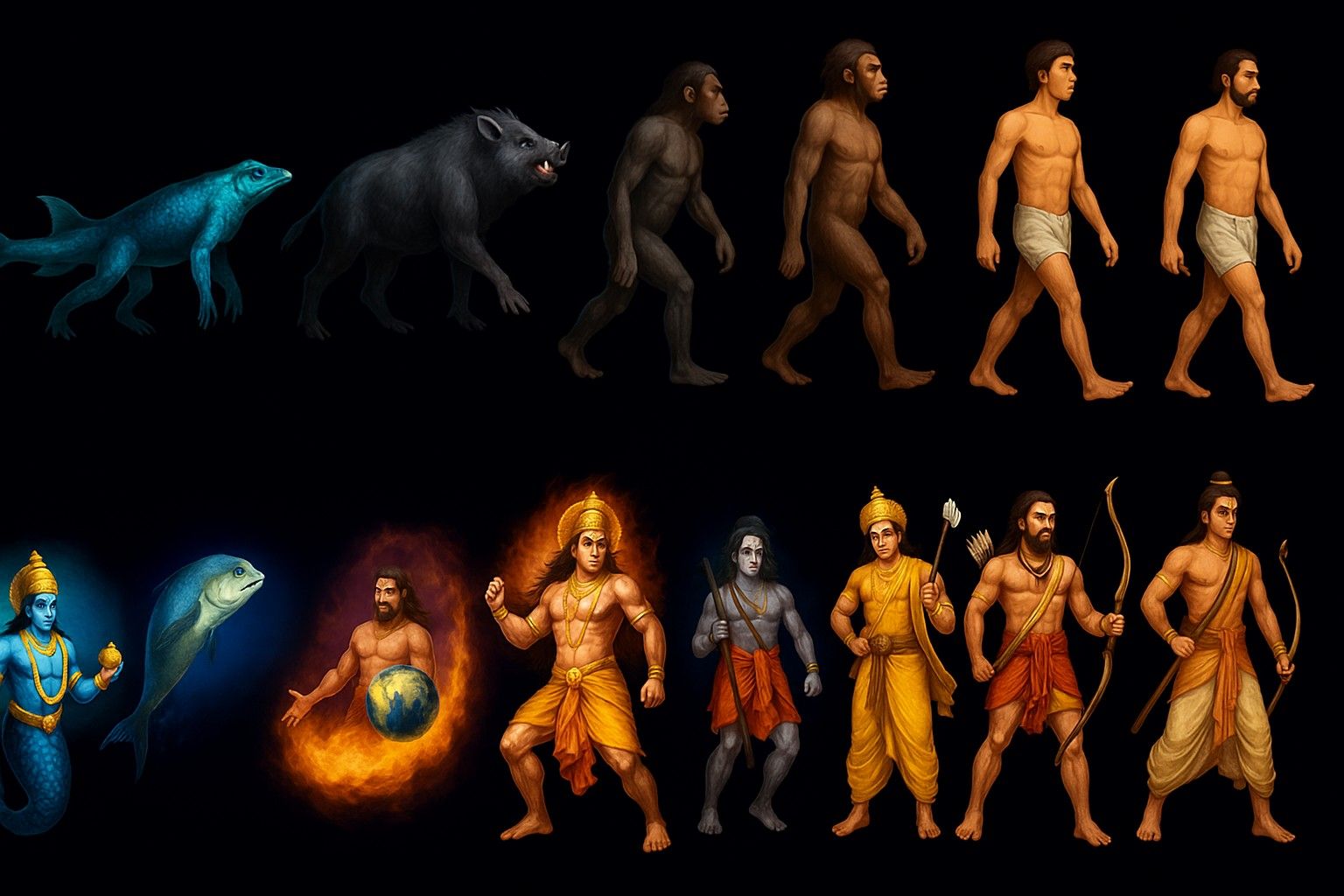Vishnu Puran said to be written around 1000 BCE ago (at least 3000 years old or maybe much more) that came to be known as the intellectual Vyasa. On the other hand, Charles Darwin proposed the Theory Of Evolution in 1859 (less than 200 years). His theory came out to be similar to the one stated in the Vishnu Puran.
The Vishnu Purana and Darwin’s theory of evolution are distinct perspectives on the origin and development of life, with the Vishnu Purana offering a mythological account of the universe and the Dashavatara, while Darwin’s theory is a scientific explanation of evolution based on natural selection and genetic variation. While some interpretations of the Dashavatara have been linked to evolutionary ideas, the two frameworks are fundamentally different in their approach and scope.
Ten Incarnations of Lord Vishnu in Vishnu Puran Vs Darwin’s Theory of Evolution
Ten Incarnation of Lord Vishnu and the theory of human evolution proposed by Charles Darwin in 1859. Each avatar stated in the epic written by Ved Vyasa, Vishnu Puran is similar to the stages explained by Darwin in his theory.
• Matsya Avatar – Fish (first stage of Darwin)
• Kurma Avatar – Turtle (second stage of Darwin)
• Varaha Avatar – Boar (third stage of Darwin)
• Narsingha Avatar – Vertebrate (fourth stage of Darwin)
• Vamana Avatar – First Ape (fifth stage of Darwin)
• Parshuram Avatar – Neanderthals (sixth stage of Darwin)
• Shri Ram Avatar – Homo-sapiens (seventh stage)
• Shri Krishna Avatar – Homo-sapiens (eight and the current state)
Summarizing the pages of Vishnu Puran, we come across that when humans evolve, their average life span reduces along with their size.
Rama, the eighth avatar of Lord Vishnu documented to be 8 ft. tall. He ruled over Ayodhya for several years after returning from 14 years of his exile. On the other hand, the ninth avatar of Lord Vishnu (Krishna) documented to be around 7 feet tall. He lived for 125 years.
The actual life on earth started from marine (water) in the form of a fish. Slowly their struggle to survive on terrestrial became their reason for evolution as amphibians. The struggling kept on gaining pace, and life started changing its form as a boar that is a terrestrial animal. This form is often used, as the age of the dinosaurs in some books. After boar, the evolution goes to vertebrate, and gradually we end up in our current form known as humans.
According to mythology, after Ved Vyas was done with the writing of the epic Mahabharata, he was indulged in writing 19 Mahapuranas. Vishnu Puran is one of them. It not only defines the evolution in the form of humans but also gives a detailed description of the physical, social, and intellectual attributes of a man.
As we get to the pages of Mahabharata, Garuda Puran, Vishnu Puran, we know that Lord Vishnu has ten great incarnations that are similar to Darwin’s Theory of Evolution. Many liberals and atheists state that the Incarnation of Lord Vishnu is nothing more than just the imagination of some person. But if it is an image, then how does it resemble the theories proposed by Charles Darwin.
Charles Darwin proposed his theory less than 200 years ago that points to the fact that Sanatan people were way before aware and known to the Evolution of Human Beings. It showcases that our ancestors knew many things that we are discovering today. The epics tell the evolutionary story in a much simpler manner (tales) than that we read today.
Our sages narrated the theory of evolution entirely in the form of stories. If we bring out these tales as a bed-time story or something else in our daily lives, then we can teach complex theories of evolution to our children in a much simpler way. This will help our children to grow precisely in their studies as well as in culture.
Here’s a more detailed breakdown:
Vishnu Purana and the Dashavatara:
Mythological Account:
The Vishnu Purana is a Hindu scripture that provides a cosmological narrative, including the story of the Dashavatara (ten incarnations of Vishnu).
Dashavatara as a Sequence:
The Dashavatara are often interpreted as a sequential depiction of the unfolding of creation and the evolution of life, with each avatar representing a different stage or form of life. For example, Matsya (the fish avatar) is seen as representing the beginning of life in water, while Kurma (the turtle) symbolizes the transition from water to land.
Theistic Perspective:
The Dashavatara narrative is rooted in a theistic framework, suggesting that life is a manifestation of the divine and that evolution is part of a larger cosmic plan orchestrated by Vishnu.
Focus on Divine Intervention:
The Vishnu Purana emphasizes divine intervention and the role of Vishnu in preserving cosmic order and bringing the universe into harmony.
Darwin’s Theory of Evolution:
Scientific Explanation:
Darwin’s theory of evolution, outlined in his book “On the Origin of Species,” is a scientific explanation of how life has changed over time through natural selection.
Natural Selection:
Darwin’s theory posits that natural selection, the process where organisms with advantageous traits are more likely to survive and reproduce, is the driving force behind evolution.
Genetic Variation:
Darwin’s theory also emphasizes the role of genetic variation within populations, where differences in traits can be passed down to offspring, leading to adaptation and the emergence of new species.
Atheistic Perspective:
Darwin’s theory is often associated with an atheistic or non-theistic worldview, as it focuses on natural processes rather than divine intervention as the primary mechanism of change.
Points of Comparison and Contrast:
Shared Concept of Change:
Both the Vishnu Purana and Darwin’s theory acknowledge that life changes over time, whether through divine intervention or natural selection.
Different Mechanisms:
The Vishnu Purana attributes change to the divine, while Darwin’s theory focuses on natural processes like natural selection and genetic variation.
Different Focus:
The Vishnu Purana emphasizes the role of a supreme being in creation and the evolution of life, while Darwin’s theory focuses on the natural processes that lead to adaptation and diversification.
Scientific vs. Mythological:
Darwin’s theory is a scientific framework supported by evidence, while the Vishnu Purana is a mythological narrative rooted in religious belief. In conclusion, while some interpretations of the Dashavatara may be loosely compared to evolutionary ideas, the Vishnu Purana and Darwin’s theory of evolution are fundamentally different in their approach, scope, and underlying assumptions. The Vishnu Purana offers a mythological perspective rooted in a theistic worldview, while Darwin’s theory provides a scientific explanation of evolution based on natural processes.
– Dr. Preenon Bagchi, Dean
Faculty of Engineering & Technology, Madhav University

